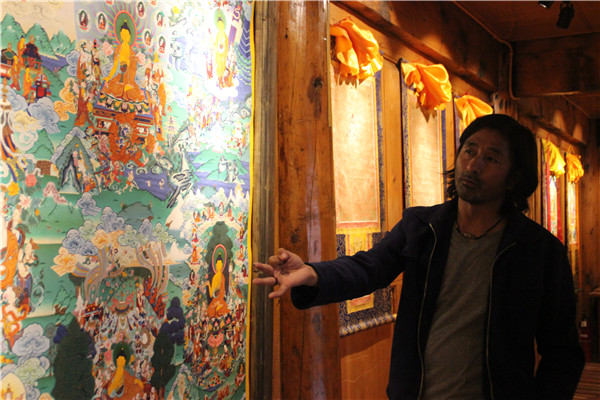 |
|
Entrepreneur Dakpa Kelden runs a school in Shangri La for those with interest in thankga art. [Photo by Shi Wenzhi/China Daily] |
The company has invested 45 million yuan of its planned 98.84 million, Karma Tachen says.
While domestic sales have been limited to Yunnan so far, they will likely enter Sichuan, the Tibet autonomous region, and Qinghai province in the country's northwest, later this year.
Their beer bottles come with artwork inspired by Tibetan folk stories. But the demand for craft beer among the local youth has yet to pick up.
Shangri La's mysticism and fine summer weather have drawn many foreign tourists over the years, but there are few settlers among the visitors.
Cafe owner Uttara Sarkar Crees came to Shangri La nearly 20 years ago and has since stayed. She had lived in Africa, Nepal and her home country, India, prior to beginning a life in China.
Shangri La has always been rich in culture and biodiversity, she says.
"There's a lot more integration among the ethnic communities today."
A deadly fire raged through the old parts of the town for hours in January 2014, dealing a big blow to more than 300 business establishments, including hers. Although the rebuilding is ongoing, tourist numbers have fallen in the past two years because of the large-scale destruction of restaurants and hotels.
"Some expats moved out after the fire," says Guillaume de Penfentenyo, a partner at Flying Tigers, a bar frequented by foreigners that takes its name from the US armed forces' volunteers who helped China fight Japanese attacks during World War II.
Before settling down in Shangri La in 2015, the 29-year-old man from France had lived in the city of Wuxi in East China's Jiangsu province for a while.
He says property rents here have increased in recent times and essential commodities like vegetables are expensive because local traders get them from other parts of Yunnan.
He doesn't find Shangri La exotic or laid-back-rather a place with a "quality of life".
Contact the writer at satarupa@chinadaily.com.cn